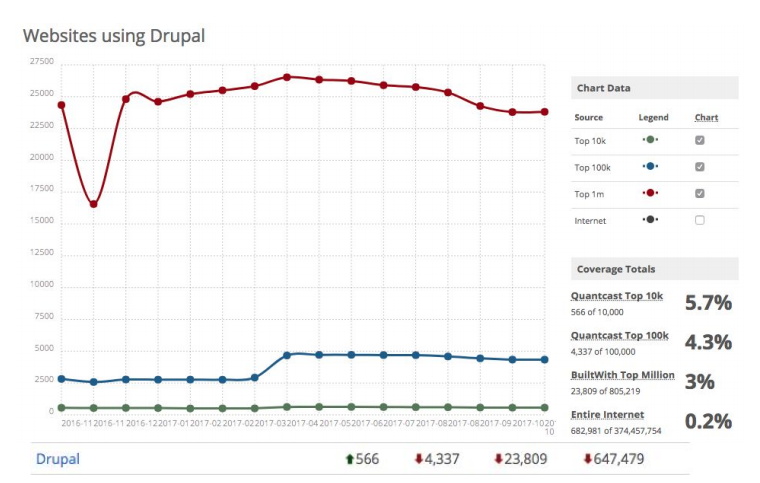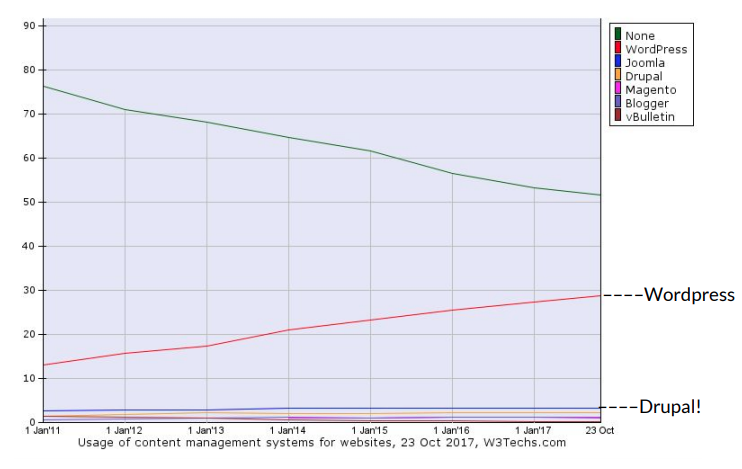Are you pondering whether Drupal has attained the peak of success? Major CMS platforms are vying hard to stand apart and prove their mettle in this fast evolving internet world. Millions of websites are reaping the benefits of Drupal 8 and its great features. It is, of course, a much-improved version in comparison to Drupal 7.
It has a come a long way since its inception. DrupalSouth Auckland 2017 had a discussion that contemplated its place in the CMS market. This was a very focused and relevant theme that resonated with the community. No wonder, it was revisited in DrupalCon Nashville 2018.
Are we witnessing the best of Drupal?
Drupal powers a plethora of websites
Yay! You read it right! Over a million websites are running on Drupal. The upward trajectory took shape halfway through 2014. This was the time when version 7 was loved by the world over.
The trajectory took a downward path when version 8 was released next year. The number of websites using Drupal remained stagnant (as shown in the red circle below).

Version 8 was a major upgrade and needed a complete overhaul of architectural setup. Those had new projects lined up were apprehensive about choosing this new version. Largely because they wanted to read case studies with the proven success of its incorporation.
Furthermore, Version 7 was already a decade old and business organizations were not keen to build their new site in it. Its fraternity had to encounter a tough time in 2016 due to deteriorating interest in its framework.
Version 8 is now a much better established and growing platform. With the decreasing popularity of Drupal 7, a steadfast growth can be seen in the usage of Drupal 8 ( as shown in the green circle above). It is estimated that Drupal 8's usage might wind up surpassing that of Drupal 7 (as shown below).

Old guns need to pave way for the new ones. That’s the norm. Technology is defined by innovation and new ones tend to replace existing ones.
Artificial Intelligence and chatbots are among the several disruptive technologies that will dominate in the near future, reports Financial Express. As per Nielsen’s data, 1.2 billion Indians will own a smartphone by 2030. That’s a 4.5 times increase and almost 90 percent people will be hooked to their mobile devices for consuming online information. This shows that adoption of technology always follows a different trend from time to time.
So, coming back to its usage among business enterprises, it all boils down to two aspects - small scale and large scale websites. According to a data by BuiltWith, there is an appalling rise in the number of large-scale sites going for Drupal. 5.7 percent of the top 10,000 websites are running on it.

It is not the same with the small-scale sites. 4.3 percent of the top 100,000 sites and only 3 percent of the top million sites are powered by Drupal.
Approximately 680,000 Drupal sites are mentioned on BuiltWith. This shows that nearly 500,000 websites mentioned on Drupal.org are supposed to be development and staging sites.

A research study by W3Techs states that Wordpress has gained ground in the market share. It was largely because of its ominous presence in the small-scale sites.
So, where does Drupal sit in vis-à-vis other CMS platforms?
Drupal’s rank among the major CMS platforms
Drupal has weathered headwinds posed by Wordpress to other CMS platforms like Joomla whose market share has gone down to less than 1 percent. It’s robust and engaging community has made sure that it stays on track.
Apparently, Wordpress and SaaS CMS like Squarespace are having a huge presence in the smaller brochure-way style sites. Even an erstwhile stronghold of Drupal, the nonprofit sector, is being dominated by SaaS platforms like Nationbuilder. Even the e-commerce sites are turning to SaaS platforms like Shopify, open source software like Magento, and enterprise platforms like SAP.
Decoupling Drupal can play a vital role as the back-end framework for React or Angular Javascript front-ends. SaaS offerings like Contentful and Directus, with proprietary platforms like Kentico, are vying to power decoupled frontends.
Version 8 can also come out a dominant force in the field of web applications. If business conglomerates want their web app to have large-scale content and easy user handling, Drupal is destined to rule this field.
It is a force to reckon with in the Enterprise CMS sector. It fares better than proprietary platforms like Adobe Experience Manager and Sitecore. It has a firm presence in key industries like digital government, higher education, and digital media.
These industries favor large-scale platforms, enormous content dissemination, a large number of users, high scalability, and a superabundance of third-party application integration. For them, Agile methodology, speed to market and cost-effective solution far outweigh everything else.
How is Drupal coping with the hyper-competitive stance of Enterprise CMS platforms?
Enterprise CMS platforms market their global products in a unified stack through a long-standing relationship with digital agencies. Likewise, Acquia has marketed their platform by using Drupal as a CMS component.

Acquia has made itself a part of Enterprise clients in the Gartner Magic Quadrant for CMS. This has helped smaller Drupal-based digital agencies to lend their services to big clients. That means Enterprise customers can get the benefits of SaaS platforms and still keep up their core CMS.
What’s the best version of Drupal?
This is pretty obvious going by the facts stated above.
Drupal 8 is the de facto choice of version that you can opt for without much thought.
There are two official releases of Drupal that is supported - Drupal 7 and Drupal 8. Its fraternity recommends that you should always run one of the official releases. It is recommended that you go for the newest version. Drupal 6 has neared its End of Life.
D7 and D8 are currently having constant updates and critical security fixes through regular security patch releases.
Version 8 is newer and has more enhanced features than Version 7. It will be supported longer. But there are contributed modules, themes, translations, and installation profiles that are compatible with each major release series sometimes lags behind Drupal itself.
Drupal 8 betterments
It comes bundled with out-of-the-box capabilities. Let us look at some of the high-level points which makes Drupal 8 truly great.
The inline form errors module lends supports for all the forms on the website for managing form errors and their display. Be it a custom form coded with the Form API, a form created using webforms module or a form created using core forms module, you just have to turn this module on to work these out.
It comes packed with Content Moderation and Workflows. The former helps in categorizing the state of your content as published, draft or archived. And the latter helps in defining these states and their transitions. Thus, if you wanted to review a content before publishing, you can just create a new state called review.
There is an advanced caching system. Dynamic Page Cache confronts with anonymous and logged in users. It also manages cache contexts and placeholders to deal with personalized parts of the page. Internal Page Cache does the caching for the whole page.
Restful module project also lends a huge help for decoupling solutions.
It has adopted package management style workflow using composer. This has helped developers immensely in development and deployment processes.
Package managers read from a manifest of dependencies that need to be included for the core project. When you build a project using it, modules and PHP libraries that you define are included in the composer.json file.
So you just have to store your core code in source control and run commands to get the requested files.
Handling translation is easier than ever before. With just 4 core modules to make your site multilingual, you can localize not only your content but blocks, users or taxonomy terms as well.
It comes with better blocks. It lets you define block once and create multiple instances. You can also create custom block types with fields.
Provision of Date field, CKEditor, and Views in the core is a praiseworthy improvement.
It uses twig templates which benefits developers who have worked on other frameworks that have a separate layer for output.
Making upgrades easier, it has made rampant changes in their release cycle. Previously, there used to be a huge gap of time period between the release of two versions. Also, there were vast differences between them. This led to complete the rewriting of architectural setup while rebuilding the site.
With version 8, an initiative has been taken to release more often and also eventually move on to Drupal 9 without taking a detour from their existing setup.
With this shift in approach towards release cycle, it has also adopted semantic versioning. This assists in identifying when the alterations can hamper your existing code.
Future of Drupal 8
How does the future for Drupal look like?
As we have already seen, its market share will drop considerably as it is losing its territory in small-scale sites to the SaaS platforms. But this does not deter its growth.
Key industries like digital government, higher education, digital media and Enterprise clients opting for large-scale sites. They are upgrading or switching from version 7 or proprietary platforms to version 8.
Small digital firms providing Drupal services through a partnership with global agencies can complement Drupal 8 as a CMS. This ensures that burden of contributing improvements in the core code is not shared by small agencies alone.
Suffice to say that peak of Drupal has already gone and Drupal 8 is here to stay and dominate large-scale projects.
Summary
Competing against the major CMS platforms, Drupal has made a name for itself powering over a million websites.
Although it lags behind in its adoption by small-scale sites, it has gained traction among the large enterprises who are in need of large-scale and responsive sites.
Drupal 7 and Drupal 8 are currently official releases that you should be adopting. Version 8 should be your choice if you are looking for long-term stability.
Version 8 has done tremendous improvements in comparison to its previous version coming up with built-in features.
Future looks bright as major industries like governmental organizations and large enterprise clients, higher education sector, and media and publishing companies are looking to extract the benefits of Version 8.
Are you looking for a better yield out of your Drupal 8 site? Contact us at [email protected]
Subscribe
Related Blogs
Inside the Drupal AI Summit: Themes, Speaker and What To Expect

“ The web is changing fast, and AI is rewriting the rules. It writes content, builds pages, and answers questions directly,…
FOST and Drupal AI Initiative: Next Era of Responsible AI

Three years after the launch of generative AI tools marked a new age for artificial intelligence, almost 90% of survey…
Drupal AI Ecosystem Part 5: AI Content Suggestions

Drupal has steadily evolved from being just a content management system into a flexible platform that incorporates emerging…




